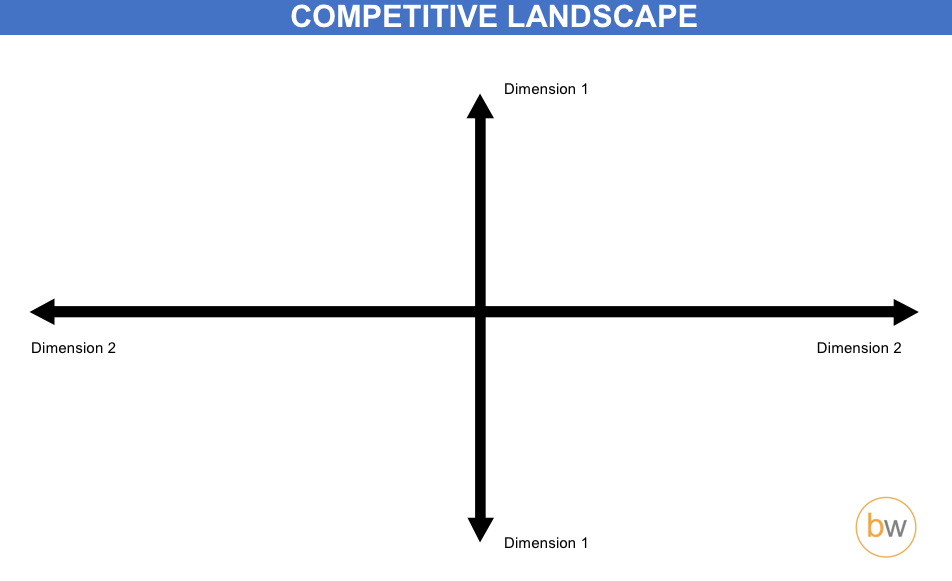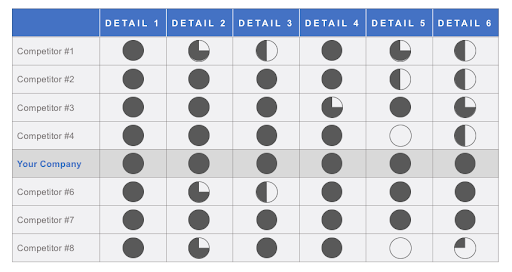In today’s fast-paced business environment and competitive landscape, crafting a compelling pitch deck is an essential skill for launching a new product or business. A key component of any effective deck is the competitor analysis slide. This slide is not just a requirement; it’s a strategic tool that allows you to showcase your understanding of the market and your competitive advantage.
Whether you’re an entrepreneur, a startup founder, or a business student, having a well-crafted competitor analysis slide can make a significant difference in how your business pitch is received. Our free competition slide template is designed to simplify this process, ensuring that you convey the most critical information in an engaging and informative way.
Download our competitive analysis slide template here for free.
What Is a Competitive Analysis Slide?
The competitive analysis slide of a pitch deck articulates what sets your business apart from others in the market. It’s a vital analysis of your business strategy that may shape key focuses like fundraising, marketing, and product development. Ultimately, a well-executed competitive analysis chart displays how and why you’ll have a competitive advantage as you pursue a go-to-market strategy.
Our competitor analysis template for PowerPoint can be downloaded for free here and put to use in your own deck immediately. It’s a simple template, but read on to learn how a 2×2 grid has been used by many successful, global companies to conduct their competitor analyses.

Our competitor analysis slide is available for download.
Competitor Analysis Template for Powerpoint
Our competitors slide template serves as a visual summary of your market research, highlighting your competitors’ strengths and weaknesses compared to your own offering. The template slide can be easily dropped into your PowerPoint pitch deck, as well as other tools like Google Slides.
Regardless of whether you’re actively presenting a pitch deck to investors or early contributors to your business venture, fleshing out a competitive analysis PowerPoint slide is a productive exercise. You never know when you’ll need to lean on such a slide—even if just to create a future reminder for yourself of where your head was at in the early days of building your business.
Competitor Analysis Examples
You may be wondering: how can such a simple competitive analysis slide be so useful? The reality is it’s incredibly hard to capture market share. It takes lots of focus for a company to compete on any one dimension. Committing to being the market leader in two dimensions is an excellent starting point.
Don’t just take it from us. The early competitor analyses from Airbnb and LinkedIn shed some light on how it’s done correctly. The following are real life examples from the companies’ early days, pulled from investor pitch decks.
Aribnb’s Competitor Analysis Slide

Competitors slide for Airbnb.
With Airbnb’s competitive analysis slide, we see two dimensions: price (affordable vs. expensive) and transaction type (offline vs. online). Dubbed “AirBed&Breakfast” in its early days, Airbnb stood out from its competitors by offering an affordable lodging service that heavily leveraged an online platform for transactions. At the time, Aribnb’s place as a leader in these two dimensions made it clear how they had a competitive advantage.
Articulating its attractive positioning in the competitive landscape shaped Airbnb’s ability to attract investors, early employees, and ultimately, customers who benefited from its value propositions.
LinkedIn’s Competitor Analysis Slide

LinkedIn’s competitor slide from their original pitch deck.
With LinkedIn’s early competitors slide, the social media powerhouse leveraged two dimensions: focus type (social vs. professional) and platform type (software vs. website). At the time, a professional networking website was an innovation that—as history would show—enjoyed a well-received place in the market.
Once again here, we see the power of excelling in just two market dimensions. How many of the other logos do you recognize in this graphic? Probably not many! This highlights just how difficult it can be to achieve longevity in the market—and why your go-to-market strategy must consider your competitive advantages.
Three Tips for The Competitive Analysis Template
Whether you’re aiming to use our competitor analysis template for PowerPoint, Google Slides, or another presentation platform, it’s important to study how to use it correctly. Here are three pro tips for using our template to its fullest potential.
1. Dive Into Your Market Dynamics
When crafting a competitive analysis pitch deck slide, think deeply about your market. Your slide has limited space and the X- and Y-axes should effectively highlight the most significant opportunities for your business. This requires a careful selection of your dimensions, which should be based on extensive research and a comprehensive understanding of your market.
To identify some worthwhile dimensions, consider a variety of research methods:
- User or Customer Interviews: Engage with people in your target market, especially if you have pre-existing relationships in your industry. First-hand feedback is invaluable.
- Consult with Industry Experts: Leverage your network or utilize professional groups to gain insights from those with deep industry knowledge.
- In-depth Market Reports: Utilize resources from investment banks, consulting firms, and research companies to understand broader market trends and dynamics.
- Analysis of Current News: Stay updated with the latest news and trends relevant to your market with an eye toward emerging competitive advantages.
By casting a wide net in your research, you can develop a well-rounded view of the market. A comprehensive understanding is essential in identifying the dimensions that are most critical for your business, ensuring your competitive analysis slide is both impactful and informative.
2. Refine Your Competitive Edge
When defining the unique aspect of your business in a competitor analysis slide, it’s common to consider competing on price. However, we recommend thinking beyond this and exploring other dimensions of differentiation. Focusing solely on price may raise concerns among stakeholders—especially investors—about the sustainability of your profit margins.
To diversify beyond price as your competitive dimension, here are some recommendations:
- Customer Segmentation: Investigate whether your business is attracting a new market segment. For instance, is your product designed for an underserved audience? Think back to our LinkedIn example. The professional/business audience needed an accessible form of social media, and LinkedIn filled that need better than anyone else.
- Product Features: Assess if there are unique and distinct features in your product. Airbnb, for instance, initially set itself apart with its end-to-end online booking experience—a novel feature at the time.
- Business Model Innovation: Consider if your business introduces a new model in your industry. For example, could you be the pioneer of a subscription model in your market category? The past decade saw hundreds of success stories of companies that did exactly that.
By thoroughly evaluating these dimensions, you can identify a more robust and sustainable competitive edge for your business—one that resonates with stakeholders and gives you a distinct position in the market.
3. Remember, You Can Always Expand Your Analysis
As your business grows and/or pivots, you may find that the simple 2×2 analysis needs to go a bit deeper. To account for more nuances and a wider set of dimensions, we recommend an expanded competitive analysis tool called the Harvey Balls, which looks something like this:
For even more templates that may help you on your competitor analysis journey, check out some of our other favorites:
For those looking to build a more robust business acumen, we also recommend downloading the syllabus for our Business Intensive. We teach 8 core business skills in 6 weeks via our micro MBA. You’d be hard-pressed to find a more efficient and cost-effective way to level-up your business skills!

